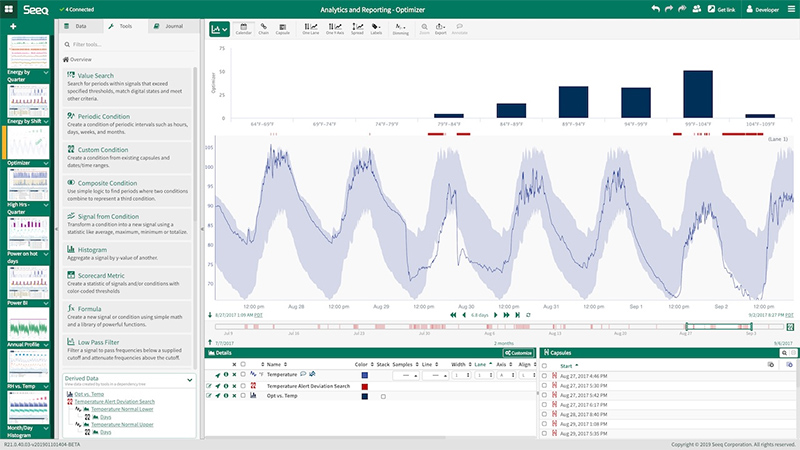Has your operation made the world-renowned “journey to the cloud?” With cloud data centers predicted to process 94% of workloads in 2021, it’s important to understand all that cloud computing offers.
The popularity of this service within the industrial and manufacturing world has grown exponentially, as have the benefits it has come to offer. No longer are cloud services only for increasing your data storage capabilities, but they have transformed to go hand-in-hand with machine learning, the Industrial Internet of Things (IIoT), and the digital transformation.
Cloud computing, in general, replaces using physical data centers and servers with on-demand IT resources via the internet. Amazon Web Services (AWS) is perhaps one of the most widely known cloud vendors, offering pay-as-you-go pricing and access to several technology process tools that reach far beyond just convenient, immediately retrievable storage.
Some of the most popular uses for cloud computing include:
- Data backup and storage
- Disaster recovery
- Virtual desktops
- Software development and testing
- Big data analytics
- Customer-facing web applications.
Read more: What Amazon can teach us about digital transformation in manufacturing
Types of Clouds
No, we aren’t talking about what’s in the sky. With three different, flexible types of cloud computing solutions, you can make sure the service is fit for your organisation’s needs.
SaaS (Software as a Service) - Most of the time, this solution type is representing end-user applications on the web. This is available as a complete product, replacing the need to monitor how the service is maintained or infrastructure is managed with only how you will use the specific software.
PaaS (Platform as a Service) - Instead of devoting your energy to managing hardware and operating systems and their resource procurement, capacity planning, and maintenance; this solution provides the opportunity to focus more on deploying and managing applications. This is a perfect environment for testing applications as well as developing them.
IaaS (Infrastructure as a Service) - This type consists of the basic building blocks for IT within a flexible and easily manageable virtual environment. Implementation offers networking features, computers, and data storage space.
What can cloud content do for you?
A “zero square foot data center.”
With a completely virtual data center, companies can save a tremendous amount of money. The cost of an on premise server in a data center can be 50 times more than the price of just the server itself. “Lift and shift” is a process happening with historians being transitioned to the cloud. Many virtual machines being hosted by one server to run several applications and improve hardware utilization replaces having to utilize a single server for each application.
Fishing for data in a stocked lake
Data lakes are a cloud-based aggregation of all your data from different sensors, servers, and applications can live and be accessed. Your disparate data can live in one platform, which enables your engineers and IT experts to look for insights to improve production and business outcomes that are reflective of your entire operation. Data lakes store raw data, so it’s necessary to have defined mechanisms to catalog and secure this data in order to gain the most value. This process can be done in incremental steps, and Nukon can help to guide you through these steps.
Answering the known questions
Your data scientists, process engineers, and business analysts all need access to your data in the cloud for analytics and insights. When coupled with BI products, cloud-based data sources can make business data more accessible, offering a single point of truth that can be easily distributed to stakeholders via a shared link.
While the ability to share is high with cloud-based systems, security is often a sticking point. If security is set up correctly, cloud systems can be just as secure as in-house systems. Different access levels and security policies can be applied to restrict access and manage risk of a breach.
Analytics at your fingertips
For the SaaS model end-users, fast browser processing, low costs, and little effort for deployment are immediate benefits. But looking further, faster insights are also available and fit a high priority for operations who implement.
Descriptive or diagnostic analytics are very important, however will only take you so far. Predictive analytics combines cloud computing with machine learning, as it takes time series and historian data to make accurate predictions on the future health of assets at manufacturing operations. Additionally, end-users can take advantage of SaaS applications with little to no previous experience in the IT world.

Seeq's SaaS advanced analytics application combines historian and time series data for
easy analysis and insight that can improve operations.
A real-world cloud computing example
Nukon worked with Container Deposit Systems to implement a low-cost cloud-based system for their recycling terminals. Cloud systems were selected as part of the development of the semi-automated return terminals to ensure reliability and scalability.
The redemption terminals sort and count the containers being returned, with all data, including transactional data from the refund processing, saved to the cloud for reporting.
Read more: IoT and PaaS deployed in War on Waste
Megan Buntain, director of cloud partnerships at process-industry-analytics firm Seeq says that companies are increasingly taking operational analytics to the cloud for three reasons: “They want that value chain efficiency. They want global operational performance. And they want to make that data available for machine-learning capabilities.”
Cloud computing has only grown in popularity and capability, so now is the right time to get manufacturing and industrial organisations properly on board to start taking advantage of the benefits.





